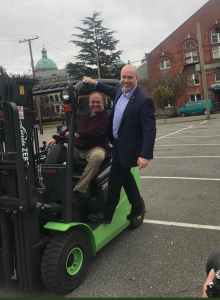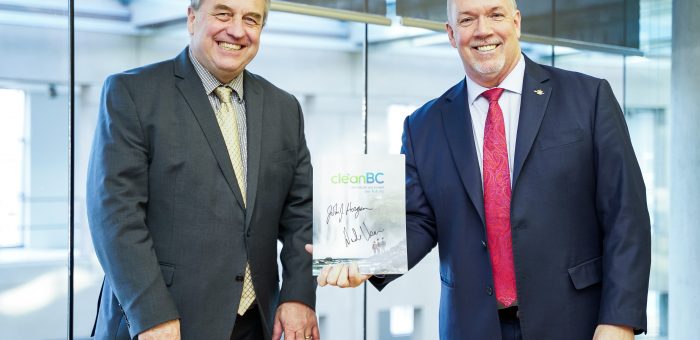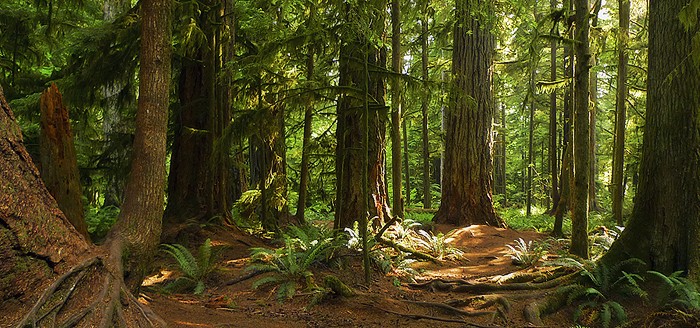Environment
From laggard to leader: CleanBC repositions BC as a leader in the 21st century low carbon economy
 Today I joined Premier John Horgan, Minister George Heyman and Minister Michelle Mungall in Vancouver to announce British Columbia’s new CleanBC economic plan aimed at positioning BC as a leader in the 21st century, low carbon economy.
Today I joined Premier John Horgan, Minister George Heyman and Minister Michelle Mungall in Vancouver to announce British Columbia’s new CleanBC economic plan aimed at positioning BC as a leader in the 21st century, low carbon economy.
This announcement was very important to me as it represented the culmination of several years work. As anyone who watched the documentary Running on Climate will know, I originally ran for office in 2013 with the BC Green Party as a point of principle — I could not stand by and watch Gordon Campbell’s legacy of leadership in the low carbon economy be dismantled by the Christy Clark government.
Today’s announcement repositions BC on the path to realize a 40% reduction in greenhouse gas emissions, relative to 2007 levels, by 2030. What’s especially exciting about today’s announcement is that it re-emphasizes the reality that reducing greenhouse gas emissions will lead to economic opportunity and prosperity for BC.
Below I reproduce the speaking notes I was planning to follow (although I went off script) along with the accompanying press release, and my overall reaction to the plan (in video).
Speaking Notes
 Over the last 150 years, Earth has made a transition from the past, when climate affected the evolution of human societies, to the present, in which humans are affecting the evolution of climate and weather.
Over the last 150 years, Earth has made a transition from the past, when climate affected the evolution of human societies, to the present, in which humans are affecting the evolution of climate and weather.- What we are at risk of losing on this planet – what has already started to die off or slip away – is staggering.
- And today, as I speak to you, we are at a pivotal moment in human history: Our generation is responsible for deciding what path the future climate will take.
- We will either be complicit in allowing climate change to despoil our world – or we can fight for a different outcome for our children.
- As Sir David Attenborough said Monday in Poland at the UN Climate talks, “If we don’t take action, the collapse of our civilizations and the extinction of much of the natural world is on the horizon.”
- As a climate scientist, I have spent my entire adult life consumed by this threat and the opportunities that will come with it.
- As a professor at the University of Victoria, my students would ask me, year after year, why so little progress was being made to combat climate change. In response I would encourage them to get involved with leaders who took global warming seriously or, if there were none, to consider running for office themselves.
- I tried to take my own advice.
- In 2007, I had the honour of being on the Climate Action Team that advised Premier Gordon Campbell.
- That work led to B.C. becoming the first jurisdiction in North America to put a price on carbon.
- B.C. stood as an example of how putting a price on carbon is perfectly compatible with prosperity.
- Our emissions dropped as our economy grew.
- And when I saw that leadership and progress being dismantled by the administration that followed, I put my name forward for public office.
- I knew I would not be able to look my kids in the face if I didn’t do everything I possibly could to fight for their future.
- That fight has not been easy.
- But I am very happy and proud to be here today, to be here to say that it has been worth it.
- By tackling climate change, with carefully designed policies, B.C.’s economy can grow in new ways.
- CleanBC offers a pathway for B.C. to be on the cutting edge of the low-carbon economy.
- This plan is a vital first step towards keeping B.C.’s climate commitments.
- Climate change is daunting and overwhelming, yes, but within every challenge lies opportunity.
- We worked hard to ensure that CleanBC is not just a climate plan – it is an economic vision.
- It is not just the Ministry of Environment’s responsibility – it is an all. of. government approach.
- B.C. has all the strategic advantages needed to seize low-carbon economic opportunities and this plan will ensure we maximize our full potential.
- I have long believed that our children and grandchildren will ask us one of two questions when they look back at the beginning of this century.
- It will either be: “How could you let this happen?”
- Or, if we choose a different path, they will ask: “How did you solve this problem when so many said you couldn’t?”
- To be a climate scientist one must be an optimist. Frankly, I’ve found it helps you survive politics too.
- I am convinced my children will one day ask me the second question. And when they do I will answer:
 “We prevailed because we worked together. We saw the threat and we knew we had to deal with it.”
“We prevailed because we worked together. We saw the threat and we knew we had to deal with it.”- I am greatly encouraged by the spirit of hope and collaboration in which this plan was written and thank the government, in particular Minister Heyman, for their efforts in this regard.
- There is much work still to be done, but today I feel we are one step closer to that brighter future.
- Thank you again, to everyone who has helped us get here.
- Please join me in welcoming Minister Heyman.
Media Release
Weaver: B.C. climate plan offers pathway to low-carbon economy
For immediate release
December 5, 2018
VICTORIA, B.C. – Andrew Weaver, leader of the B.C. Green Party, says the CleanBC plan released today offers a pathway for B.C. to be on the cutting edge of the low-carbon economy. Weaver says the plan is a vital first step towards keeping B.C.’s climate commitments and looks forward to building on this progress in the months ahead.
“This plan offers a pathway for B.C. to have a thriving low-carbon economy,” said Weaver.
“Climate change is the most significant challenge facing humanity. Each megatonne of carbon we take out of the equation will bring us closer to limiting global warming, in turn limiting the economic damage, social upheaval and human suffering threatened by climate change. British Columbians should be proud that this plan can make a difference.
“Within every challenge lies opportunity. This is why we worked hard to ensure that CleanBC puts a vision for B.C.’s economy at its centre. B.C. has all the strategic advantages needed to seize low-carbon economic opportunities and this plan will ensure we maximize our full potential. I am greatly encouraged by the spirit of hope and collaboration in which this plan was written and thank the government, in particular Minister Heyman, for their efforts in this regard.
“This has been a year of hard choices for our Caucus. The decision of the government to go ahead with LNG was a low point. I will always argue that the development of new large fossil fuel infrastructure is inconsistent with our commitments under the Paris Agreement. But this plan, and the preliminary work we have done on how we will achieve the remaining reductions, give me confidence that our targets may be within reach and that they are certainly worth fighting for. I am pleased that the plan will be backed up with funding in the next budget, and that the government has agreed to enact an accountability framework to hold the current and future governments to account.
“Climate change will test every modern leader and history will judge each of us by our actions. We must come together around our shared desire to secure a bright future for our children and grandchildren and advance every available solution to limit global warming. This will require us to sit at the table with people from across the political spectrum and stay at the table even when we don’t always get exactly what we want. The scale of this challenge calls on us to ask not what is the least we can do, but what is the most we can achieve.
“This plan is a commendable start and I am proud of the work we have done to get it to this point, but we need to keep pushing forward. The time for decisive action is now and we will keep fighting for better.”
-30-
Media contact
Jillian Oliver, Press Secretary
+1 250-882-6187 | jillian.oliver@leg.bc.ca
Video of Overall Reaction
Forest Management practices in British Columbia: An exchange in Question Period
Yesterday during Question Period I rose once more to ask the Minister of Forests, Lands, Natural Resources and Rural Development about British Columbia’s forest industry. In the first question I once more asked the Minister about glyphosate (Roundup®) spraying in BC forests. This was the topic of a question I asked the Minister on November 7. In my supplemental question, I asked the Minister what he will be doing in 2019 to overhaul our important forestry industry in British Columbia.
What’s remarkable about this exchange is that as I started my initial question, Ben Stewart, the MLA for Kelowna West, heckled me loudly suggesting that I was not asking important questions. It was a head turner for me as I had just witnessed two days of the BC Liberals’ outrageous behaviour in Question Period. In fact, over the course of this entire session, the BC Liberals have asked the same questions over and over again. Very few of them have any relevance to issues that matters to British Columbians except those who take delight in the political posturing of the BC Liberals through gotcha politics.
Below I reproduce the video and text of the exchange during Question Period. Those watching the video will note the spoonerism glysophate instead of glyphosate. This was unintentional and reflects the fact that when I speak fast I sometimes utter spoonerisms.
Video of Exchange
Question
A. Weaver: A few weeks ago, I asked the Minister of Forests, Lands, Natural Resource Operations and Rural Development when B.C. would stop spraying our forests with….
Interjection.
A. Weaver: It’s interesting, as I got interrupted by a member opposite, suggesting that asking about this is not important. Rather, what it’s important, it seems to me, is the, frankly, shocking games that I’m watching going on here.
So to the member from West Kelowna who doesn’t think the issue of glyphosate spraying in British Columbia forests is important, I continue. Glyphosate kills the species that provide an essential line of defense against wildfires and pine beetle. In the member’s riding itself, in the riding of Kelowna West, we have pine and we have wildfire that he should be concerned about. Maybe he should be spending some time on this issue.
Glyphosate harms human health and animal health. It’s symptomatic of 20th century forest management practices, and as reported in Business in Vancouver last week, B.C.’s forest industry is currently undergoing falling lumber prices, production cuts and staff layoffs. We need to change our forest practices now if we are going to have flourishing sustainable ecosystems and industry.
Now, I recognize, again, that forestry is not an important issue for the members opposite. But it is on this side of the House. For that, I ask the following question to the Minister of Forests, Land and Natural Resources. What evidence is the minister still gathering to make a decision about the ongoing use of glyphosates given that the evidence seems to be very clear that we should stop now?
Answer
Hon. D. Donaldson: I welcome the question from the Leader of the Third Party. I welcome the question because it’s of interest to people in rural areas, and natural resource management is of interest to people across the province.
We’re committed to protecting the important biodiversity of forests while ensuring a continued vibrant forest sector. As the member knows, the herbicide glyphosate is approved by Health Canada for weed control and is used selectively in northern B.C. to improve survival and growth of seedlings and young trees.
Recently the ministry started to allow increased levels of aspen and broadleaf in managed stands throughout B.C., which will lead to a further decline of the use of herbicides. In fact, in certain ecosystems, up to 1,000 aspen per hectare are acceptable in conifer plantations. Overall, the use of glyphosate is decreasing. We will continue to look at any evidence to improve silviculture strategies in the province.
Supplementary Question
A. Weaver: Indigenous peoples have managed forests for their ecological, cultural and economic value for thousands of years. There’s substantial traditional knowledge surrounding forest management, and every recent report on forestry and fire has highlighted the need for Indigenous collaboration and leadership.
Another issue clearly not an important question for the member for Kelowna West is this: UBC has proposed a national Indigenous forestry school for their Okanagan campus. If developed, this program will establish a holistic curriculum that integrates Indigenous knowledge to deal with wildfire and forest health, wealth creation and governance, and how to maximize the value of our forests.
This concept is a perfect example of reconciliation and innovation in an era of climate change and, frankly, an issue that I think we should be discussing here in question period rather than the games that we’re seeing played opposite.
To the Minister of Forests, Lands and Natural Resources, there are a multitude of opportunities like the one proposed by UBC. We can and need to do better now, not tomorrow. What exactly will the minister be doing in 2019 to overhaul our important forestry industry in British Columbia?
Answer
Hon. D. Donaldson: You know, I haven’t had, in all of this fall question period session, the ability to touch on the wildfire situation that occurred in 2018. The member used wildfire examples in his question. I would just like to say, and ask all members to join me, in congratulating the B.C. Wildfire Service staff, the contractors and the volunteers who ensured that not one single life was lost in the entire 2018 season.
The member touched on a number of topics. I’ll be brief in my answer, but I wanted to first acknowledge the efforts that UBC’s faculty of forestry is bringing — I met with the dean, John Innis — to create an Okanagan campus national Indigenous forestry school. I know the Minister of Advanced Education is aware and eagerly awaiting to receive a proposal around that.
That’s in order to blend and ensure that Indigenous traditional ecological knowledge is combined with western knowledge to better manage the forest sector. That will involve ensuring that the forest sector is productive and ensures that we’re managing with both First Nations and western science.
The greatest climate change-related risks & opportunities facing the BC government?
Today during Question Period I rose to ask both the Minister of Energy, Mines & Petroleum Resources and the Minister of Forests, Lands, Natural Resource Operations & Rural Development what the greatest climate change-related risks and opportunities their ministry faces, and how they are prepared to deal with both.
With the upcoming release of the economic vision embodied in the clean growth strategy, it’s critical that every Minister is up to speed on how it will affect their Ministry.
As you will see from the exchange, I was not very impressed with the response I received from the Minister of Energy, Mines & Petroleum Resources. I felt that the response from the Minister of Forests, Lands, Natural Resource Operations & Rural Development was quite good.
Below I reproduce the text and video of the exchange with the Ministers.
Video of Exchange
Question
A. Weaver: In the span of just a few centuries, earth has transitioned from a past when climate affected the evolution of human societies to the present, in which humans are affecting the evolution of the climate system.
Today we are at a pivotal moment in human history. Our generation will be responsible for deciding the path we take and the future climate will take along with us. As elected officials, we’ll either be complicit in allowing climate change to despoil our world or we can lead the way and choose a different path.
Our provincial emissions have risen in four out of the last five years. Every minister has a responsibility to ensure that tackling this issue is within their mandate, as mitigating the impacts of climate change requires an all-of-government approach.
Accounting for 7.2 million tonnes annually, mining and upstream oil and gas production are the biggest contributors. My question to Minister of Energy, Mines and Petroleum Resources is this. What are the greatest climate change–related risks and opportunities facing your ministry and how are you prepared to deal with them?
Answer
I appreciate that for the member this is a very, very important issue that he’s very passionate about and the work that he’s done with this government to address climate change and our climate action plan.
For this ministry, in particular, we have been looking at what we can be doing as a new government to reduce our impact on climate change. The list is quite long. But I know that question period is the opposition’s time, so I won’t try to list everything. I’ll give the member a few examples of some of the things that we’re doing.
A couple of weeks ago I was at UBC talking with architect students about our new program called the better buildings B.C. program, where we’re looking for innovative ideas in terms of how we can reduce our emissions in our buildings throughout the province.
But the member brought up, specifically, mining and oil and gas. One of the things that this government did was we eliminated PST on electricity for businesses. That includes the mining sector. That includes the oil and gas sector. If they can electrify and move away from oil and gas — diesel, for example — to generate the power that they need to do their operations, we’re reducing our greenhouse gas emissions quite significantly. Those are the types of opportunities that we’re looking at.
As the member will note, I also just introduced legislation to reduce our methane emissions as well. There’s lots that we are doing, and I look forward to being able to brief the member fully at another time
Supplementary Question
A. Weaver: I must say, given the scale of the challenge as well as the scale of the opportunity, going and meeting a few people to discuss some ideas is hardly taking advantage of this opportunity and meeting the challenge. I remain quite disappointed in that response, so let me try again.
The B.C. fires of the past two summers were no surprise to the climate science community. Back in 2004, my colleagues and I published a paper in Geophysical Research Letters, pointing out that we could already detect and attribute increasing areas burnt in Canadian forest fires to human activity and, in particular, global warming.
According to the B.C. Wildfire Service, this year was the worst on record. Over 1.35 million hectares were consumed by forest fires. The fires burned homes, endangered lives and released hundreds of megatonnes of CO2. What’s happening in California is no surprise to the climate science community, yet it appears to be a surprise to politicians du jour.
We know that global warming will lead to an increased likelihood of summer drought. This, in turn, will lead to more extensive wildfires. We know that precipitation extremes will increase and that flooding events will be on the rise. This threatens human health, ecosystems and the economy.
While the members opposite are concerned about their survival as a political entity, I’m sitting here asking the minister about the political survival of all of our collective species. To the Minister of Forests, Lands, Natural Resource Operations and Rural Development, what are the greatest climate change-related risks and opportunities facing your ministry, and how are you prepared to deal with both?
Answer
Hon. D. Donaldson: As my colleague mentioned, climate change is a considerable risk for our province and planet, and we are committed to tackling it. The member and the Leader of the Third Party asks — and I appreciate — the question about opportunities and risks.
The risks are in forest systems and ecosystem resilience. Ensuring that into the future, we have forest ecosystems that are resilient to and can adapt to the climate change that we are seeing.
We are seeing it, certainly, in the forest fire situation. It’s had an impact there. Large forest fires that we saw in the past two seasons have had enormous impact on ecosystems. We’ve seen it even more recently in the level 4 drought conditions in the areas that I represent up in the northwest and unprecedented drought that has led to impacts on fisheries resources. You’ve seen the pictures of the riverbeds, extremely dry riverbeds — unprecedented.
We are working on mitigative measures. In June, we hosted the first wildfire and climate change conference. A couple of topics it focused on were creating resilient ecosystems to better adapt to climate change and mitigate wildfires and ensuring effective carbon management. Part of that is our forest carbon initiative. That’s a $290 million federal-provincial initiative that’s focusing on incremental reforestation and improving utilization of waste and reducing slash burning.
Finally, in regards to the question as far as opportunities, we also have long-term research trials, assisted migration and adaptation trials to identify seed sources most likely to best adapt to future climates. We’ve made important progress in 16 months, and we need to do more.
It’s time to stop spraying glyphosate on BC Forests
Today in the legislature I rose during Question Period to ask the Minister of Forests, Lands, Natural Resource Operations and Rural Development what his ministry was doing to curtail glyphosate spraying in BC forests. Glyphosate is the active ingredient in Monsanto’s Roundup™. It’s used to kill off broadleaf plant species that might inhibit the growth of seedlings that are replanted after a forest is logged. There are a number of significant negative impacts that arise from the current practice of widespread glyphosate spraying.
Below I reproduce the video and text of our exchange.
Video of Exchange
Question
A. Weaver: Every year in B.C., 16,000 hectares of forests are sprayed with an herbicide known as glyphosate. It’s sprayed over forests that have recently been logged and replanted to kill broadleaf plant species that might inhibit the growth of lodgepole pine seedlings. The result is reduced plant diversity, leading to monocropped forests that are vulnerable to more frequent and destructive wildfires and beetle infestations.
The World Health Organization has warned that glyphosate is likely carcinogenic. It also has genotoxic, cytotoxic and endocrine-disrupting properties. For decades, researchers have been reporting reduced numbers of rodents, moose, insects and birds in forests that have been sprayed.
To the Minister of Forest, Lands and Natural Resource Operations, if our forests exist for the monetary value once felled, glyphosate is an efficient tool. If we consider the value of our wildlife ecosystems and human health, it is a veritable threat. What are the values that inform our ongoing use of glyphosate in B.C. forests?
Supplementary Question
Hon. D. Donaldson: Thank you very much to the Leader of the Third Party for the question on glyphosate. It’s a topic that I’ve been following closely since 1990. It’s of great interest to people around B.C.
Glyphosate is broadleaf herbicide. Many members in the House might recognize it as the active ingredient in Roundup. I want to say that our government is committed to protecting the important biodiversity of forests while ensuring a continued vibrant forestry sector.
The herbicide glyphosate is approved by Health Canada for use in forest management and is used to improve survival and growth of trees. In B.C., any users must follow the Integrated Pest Management Act and take steps to minimize impacts on the environment, including fish-bearing streams, a very important consideration.
B.C.’s reforestation practices are continually updated based on new scientific research and information, and recently, the ministry started to allow increased levels of aspen and broadleaves in managed stands throughout B.C., which will lead to a further decline in the use of herbicides.
I know the member quoted a figure of 16,000 hectares where glyphosate was applied. That was a number from 2015. I’m happy to report, in 2017, that number went down to 10,000 hectares — so a decrease of almost 40 percent.
Supplementary Question
A. Weaver: Numerous jurisdictions have banned or restricted the use of glyphosate. These include the Netherlands, Germany, France, Portugal, El Salvador, Argentina and Denmark, to name but a few.
Meanwhile, in British Columbia, we continue to spray tens of thousands, or at least 10,000 hectares, of forests annually with glyphosate. We are contributing to the severity of wildfires, harming wildlife and watching the chemical work its way through our food supply, all without any sound justification.
We should be thinking about the precautionary principle here, not waiting until it’s too late. As Rachel Carson once wrote: “The right to make a dollar at whatever cost is seldom challenged. It is the public that is being asked to assume the risks.”
To the Minister of Forests, Lands, Natural Resource Operations and Rural Development, we are risking a lot for questionable benefit. How can the minister continue to justify the ongoing use of glyphosates in our provincial forests?
Answer
Hon. D. Donaldson: I want to acknowledge that we’re looking for ways to do better in the forests, especially around the application of herbicides, and so other forestry innovations, such as the use of superior orchard seed, improved nursery techniques, fast-growing seedlings and well-timed planting is also reducing the amount of herbicide being required.
We continue to investigate other silviculture strategies that take into account climate change and managing for resilient forest ecosystems. I’m very excited about the work of re-establishing forests after they’ve been disturbed by wildfires and recreating a forest mosaic so that deciduous as well as conifer stands are part of that mosaic, leading to more resilient forest eco-types.
We’ve also been doing work on the impacts of glyphosate on wildlife, specifically with moose. That’s a huge concern to many people in rural areas — moose populations. We want to make sure we’re responding to scientific evidence, and so we have a program where we’ve initiated a two-year study to look at the impacts of herbicide spraying on feed and moose forage and nutritional quality of moose forage.
We anticipate the preliminary results to be available in 2019, and we look forward to implementing that research, based on scientific evidence.
To the Premier: What’s being done to expand BC-based EV charging & manufacturing capacity?
Today in the legislature I rose during Question Period to ask the Premier what his government is doing to encourage private investment in electric vehicle charging infrastructure and EV manufacturing in British Columbia.
Below I reproduce the video and text of our exchange.
Video of Exchange
Question
 A. Weaver: We’ve talked about the last 16 years. We’ve talked about the 1990s. Let’s talk about the future now. In the second quarter of 2018, British Columbians bought 2,564 electric vehicles, more than three times the amount bought in the previous year. Across our province, dealerships can’t keep EVs on their lots. Backlogs and waiting lists vary from three months to a year, even up to 18 months, and the clean growth strategy to be released later this fall will bring in an aggressive ZEV standard to B.C.
A. Weaver: We’ve talked about the last 16 years. We’ve talked about the 1990s. Let’s talk about the future now. In the second quarter of 2018, British Columbians bought 2,564 electric vehicles, more than three times the amount bought in the previous year. Across our province, dealerships can’t keep EVs on their lots. Backlogs and waiting lists vary from three months to a year, even up to 18 months, and the clean growth strategy to be released later this fall will bring in an aggressive ZEV standard to B.C.
Charging infrastructure remains a barrier for widespread EV adoption, and B.C. Hydro, which has installed a few fast-chargers recently, has done so by giving away the electricity for free. This has led to large lineups as locals get electricity for free while those who need it and those who want to pay for it have to wait in line, hoping to get a charge at some point down the road.
B.C. manufacturing companies like Electra Meccanica, Envirotech Electric Vehicles and Environex Inc. are looking to set up here in British Columbia — manufacturing facilities that want to grow our economy and meet global demand.
My question is to the Premier. What is his government doing to encourage private investment in electric vehicle charging infrastructure and EV manufacturing in B.C.?
Answer
Hon. J. Horgan: I thank the Leader of the Third Party for the question. It’s nice to have forward-looking questions on how we’re going to build a better, stronger British Columbia, how we’re going to meet our objectives with respect to climate action, and I appreciate the question.
First of all, British Columbia does lead the country in charging stations, some 1,500. And now you can travel from Golden…. The member from Golden can travel all the way to Tofino in his electric vehicle and not have to stop and charge. As the member quite rightly says, though, we do have some challenges.
That’s why the B.C. Utilities Commission has opened up a review on their own initiative to ensure that we find a way to get electricity into electric vehicles in a way that’s cost-effective, a way that’s fair to the travelling public and allows us to build even more capacity going forward.
Lastly, I would say, with respect to electric vehicle uptake in the economy, we had to increase…. The Minister of Finance found an additional $10 million to put into the clean energy vehicle program in September because it was already oversubscribed from February. That speaks to demand in the economy. That speaks to a responsive government that’s listening to people and putting in place programs and services that will help them and help all of us meet our climate change objectives.
Supplementary Question
A. Weaver: As the Premier mentioned, obviously there are nearly 1,500 EV charging stations in British Columbia. Almost all of them give away electricity for free. Some are private; most are not. The free model is rapidly becoming unsustainable as more and more British Columbians move towards EVs.
To sell someone electricity in this province, you must be registered as a public utility unless you get some very-difficult-to-get exemption. Oregon, California, Washington, Ontario, New York and a number of other U.S. states have already exempted EV charging from energy regulation. Resale of electricity is permitted, like a gas station, without prior approval, and prices are set by the market. Of course, safety, consumer protection and other considerations are indeed regulated.
My question, then, to the minister is this. The type of approach that encourages private investment in vehicle-charging infrastructure in British Columbia is exactly the direction we want to go. Will the Premier commit his government to updating B.C.’s regulatory environment for EV charging stations immediately after receiving the recommendations from the B.C. Utilities Commission report he referred to?
Answer
Hon. J. Horgan: Again, I thank the member for his interest and passion on this subject. I also want to say that we are utilizing the B.C. Utilities Commission, unlike the previous government that sidelined this very useful regulatory body. We’re using the B.C. Utilities Commission to determine the best way forward.
The member is quite correct. He’s looked into this diligently. We do have some challenges with respect to giving away energy in some places and overcharging in others. A regulatory framework that meets the needs of the travelling public and allows us to meet our climate objectives over time is the right way forward.
I look forward — as all members, I’m sure, do — to the Utilities Commission reporting back in the fall — or in the next number of weeks, I expect — on their proposals going forward.
But I also want to touch on another component of the question that the member asked and that is how can we incent and attract the development of, the creation of construction and the implementation of a program that has a clean, green, innovative tinge to it. That would be left to the member for Surrey-Whalley, the Minister of Jobs, Training and Technology, who appointed the first innovation commissioner in B.C.’s history so that we can have an economy that works for everybody and looks forward, not backward, like the people on the other side.







